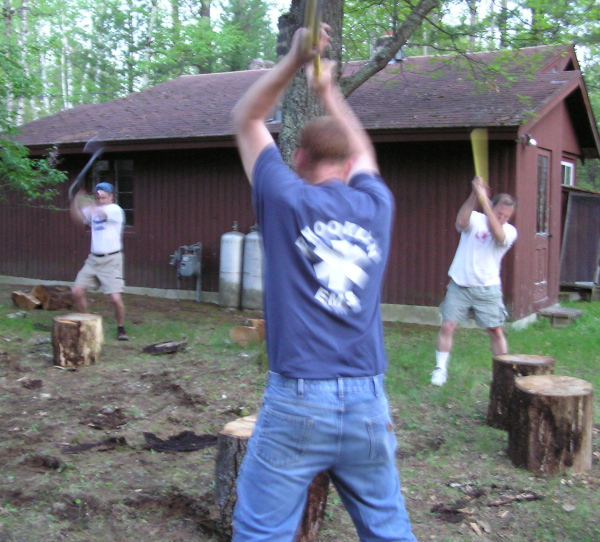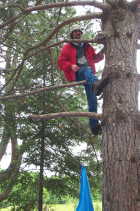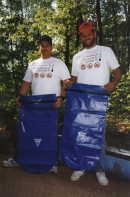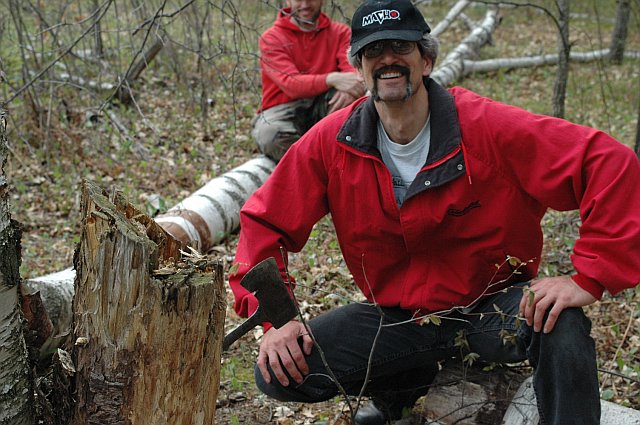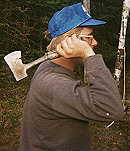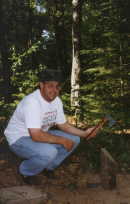Competitions
Arm Wrestling
During the trip, every participant is assigned a campsite job. At each campsite, participants are expected to perform their assigned job, plus help anyone who needs assistance. The major classes of jobs are cooking, setting up tents, gathering wood, building fires, and meal clean-up.In order to determine the job assignments, arm wrestling
competition is performed Friday night. The list of all the current
year's participants are ordered according to number of years of
participation on the He-Man.
Starting with those who have participated the most number of years,
single
elimination arm wrestling is done to see who gets to get to sign up for
a
job first. Arm wrestling is only done with those who have the same or
similar
number of years of experience. This means that typically a Rookie (a
first
year He-Man) gets to do meal clean-up.
Wood Splitting
In 2006 we decided to try something different than arm wrestling for campsite job assignment. Ron had cut down a large oak at the cabin that need splitting. So we had a competition of two or three of us at a time racing to see who could split a piece of wood first. These were very large pieces of wood, and no wedges were allowed. The jury is out on whether splitting or arm wrestling is easier.In 2016 we had the extra challenge of splitting wet wood.
Crazy Beaver Island Race
Just up stream from Fish Trap Dam is a small bay with an island in the middle of it. An unusual four lap race is performed in this bay. One lap is done paddling forward, followed by one lap which is done paddling backwards. After the second lap is completed, the person in the front and back switch places in the water. The third and fourth laps are again done where one is forward and one is backwards. At the end of each lap a cow bell (which is tied to a dead tree in the water, just outside the bay) is struck. What makes this race even more interesting is that that bay is filled with dead trees, mounds of muck, and tiny islands of shrubs. The winning team receive some sort of prize. Recently this has been two small white water bags.
Boulder Lake Race
On the second day of the trip, a race across Boulder Lake is done. The distance is approximately 3 miles. This is done with fully loaded canoes. Because of the many different types of canoes used and wide range of canoer experience, the race results are determined by teams. Boyd and Dave determine an expected ordering of how the canoes will finish in the race. This ordering is based on the speed of the canoe, experience of the canoers, and previous results. Two teams are formed. The canoes which are expected to be odd number finishers (i.e. 1st, 3rd, 5th, ..) are on one team and the even number finishers are on the other team (i.e. 2nd, 4th, 6th, ...). A team receives one point for every position they exceed from the expected ordering. For example, if the canoe expected to finish in 3rd place, actually finished in 2nd place, the Odd numbered team gets one point. The team with the most points wins. The winning team receives dessert at lunch for that day. That is the only dessert provided during the whole trip.Canoe Tug of War
On the evening of the second day or the morning of the third day, a canoe tug of war is done. A buoy is placed in the water, not far from the campsite. Two identical or nearly identical canoes are connected at the back ends with approximately 40 feet of rope. At the half way point on the rope a piece of cloth is tied. Two canoe teams take the tied canoes out into the water. They paddle the canoes so that they are facing away from each other and are parallel to the shore line. They pull the rope tight and adjust to have the piece of cloth over the buoy. Then the race begins. The first team to pull the other team's back of the canoe past the buoy wins.Over the years of doing the race, a number of important techniques have been learned. Long strokes where the blade of the paddle is completely in the water are most effective. Concentrating on having minimal air time for the paddle helps (i.e. the forward motion of moving the paddle back for another stroke should be very quick). The person in the back should try to make sure that his paddle is not out of the water at the same time his partner's paddle is out of the water. In close races, choosing the right time to switch sides will have a major impact on winning or losing the race.
Typically single elimination is used to determine the winner of the race, where winners of one round compete against each other. Because the number of canoes is not always a power of two, some unique methods are used to determine the winner. The winning canoe's partners receive trophies. Also a tradition has started where after the last round race, the canoes both dunk.
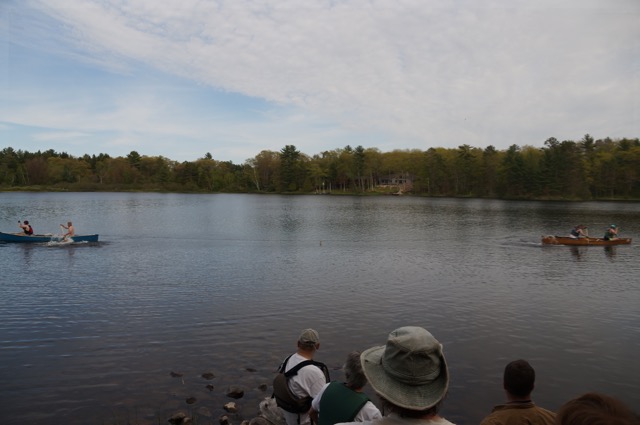

Hatchet Throw
While waiting for supper to be prepared at the second campsite, a hatchet throw competition is done. A rotting stump is chosen as a target. A number of lines are drawn at distances of about one foot apart from the stump, starting at about 3-4 feet away from the stump. The object of the competition is to advance to a line farthest from the stump. In the first round, each person gets three throws from the first line. Each time they stick the hatchet into the stump, they advance back to the next line. A person must stick at least one of the three throws in order to make it to the next round. The winner of the hatchet throw receives an engraved hatchet.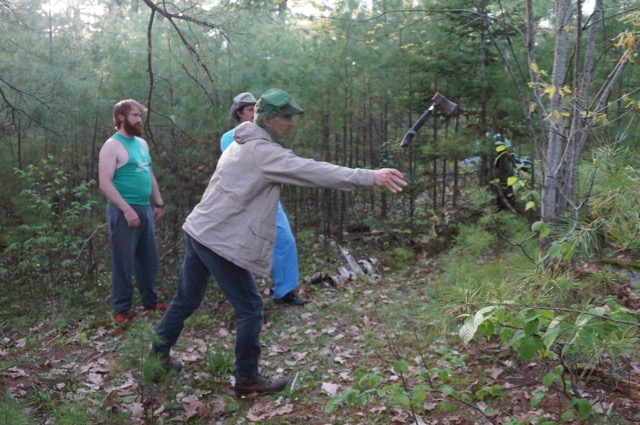
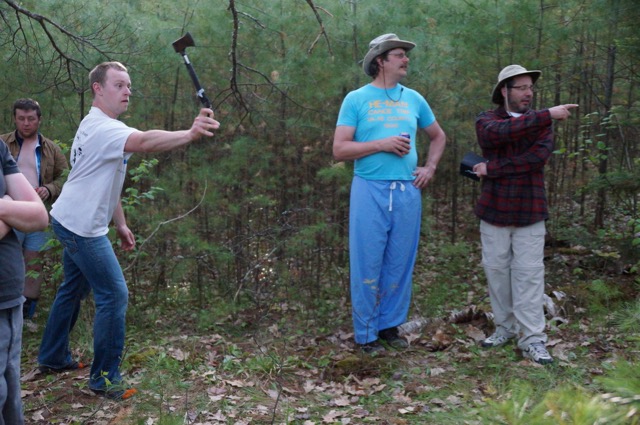
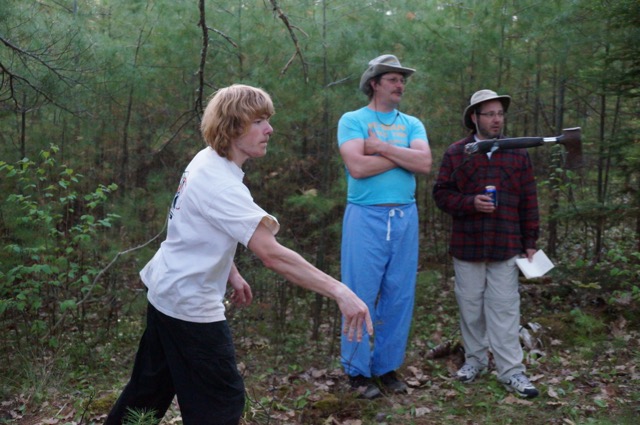
He-Man Canoe Trip Web Pages
© 1997-2022
All Rights Reserved.
Last Update: 04/11/22 09:38:31


